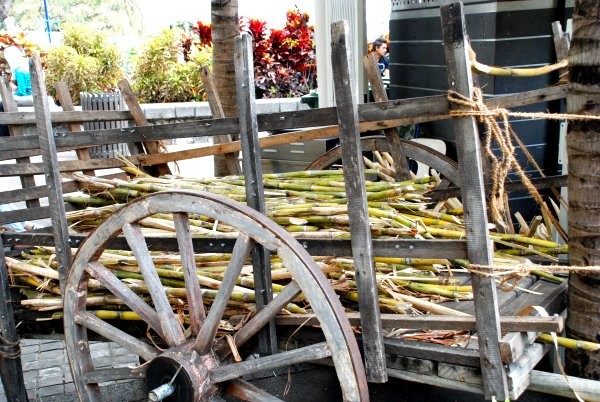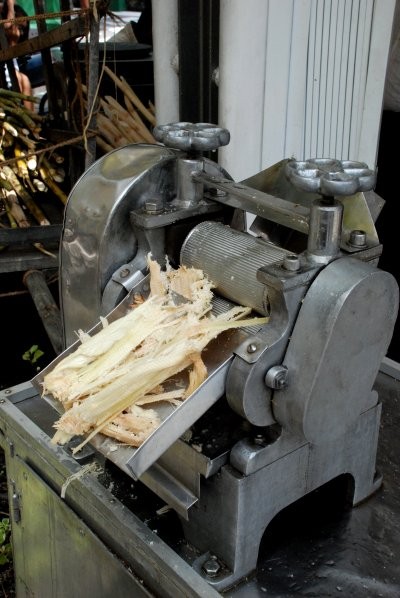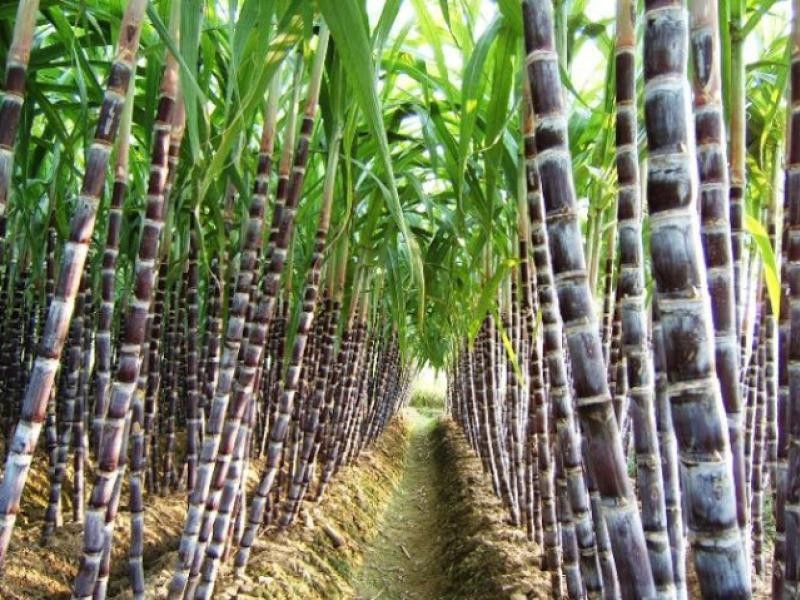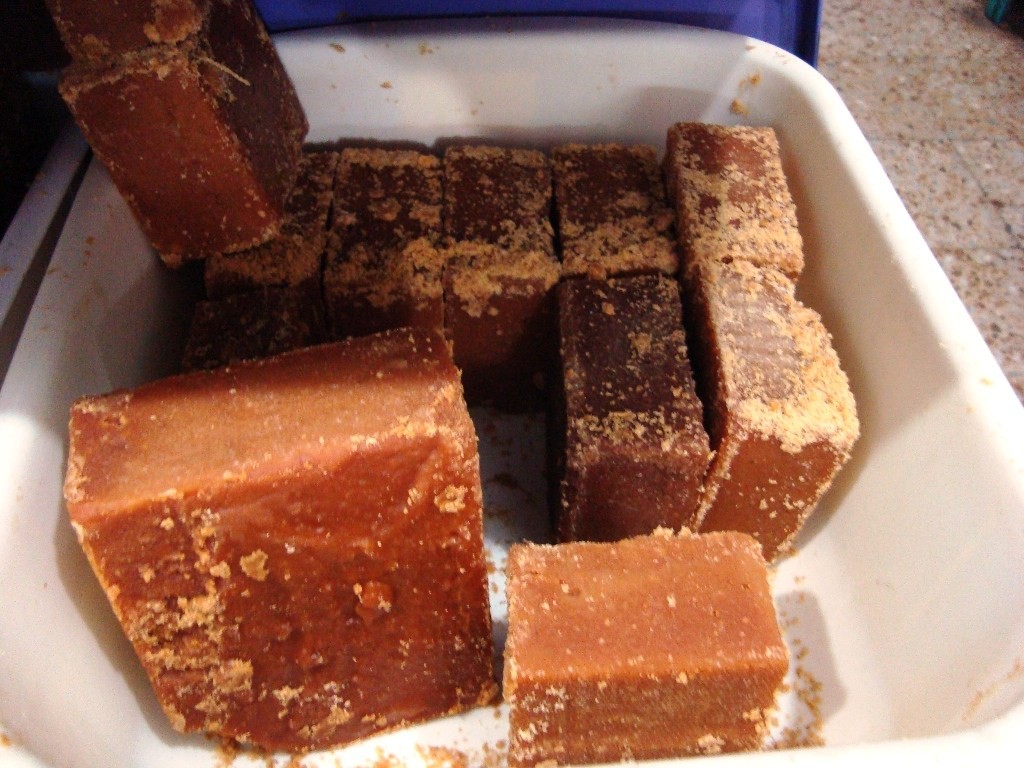Sugar cane: juice and unrefined sugar
The sugar cane gives us raw sugar, in its natural state. It can be consumed by extracting its juice (either by sucking the cane itself or by crushing it with special machinery) or by making the panela (unrefined sugar). As well as obtaining the white sugar, it is refined and processed to helps us to sweeten our recipes.
Juice / sugar cane juice
Sugar cane juice is incredibly delicious and in addition, contrary to what may seem, it is very healthy.
It is also called guarapo, although this is a more colloquial term among rural areas especially in Cuba, the Dominican Republic and Colombia. In Brazil, it is very rare to hear this name. In fact, near the end of my stay a colleague told me: "By the way, you're going to send me a glass of guarapo please" (and I had to ask him what that was... )
Once in Florianópolis, I met some Brazilian guys who took care of me and took me on some car route around the island. I tried this delicious drink for the first time with them. You can find it in different places all over the island and you can see them make it in front of you, which is something that has caught my attention a lot. Both on the beaches and in the centre of the city, you can find stalls with strange machines and on the side, lots of branches. These branches are sugar canes, which are introduced into the machine as when you want to get splinters from the wood. The machine squeezes the sugar cane like a juicer, and you get a glass of this very cool drink.

To taste it as it deserves and also to enjoy all its qualities you have to drink it freshly squeezed so the sugar does not ferment and it is like orange juice when your mother says: drink it now, as the properties will evaporate soon.

This is one of the machines where this juice is extracted. It depends on where, especially if the stalls are permanent or mobile, you may find yourself with larger or smaller machines. The sugar cane which they already have heaped up in large quantities are put on one side and the machine with some rollers inside, pressing and crushing them so that all their juice is squeezed out and comes out below. Formerly the machines were manual but today they are mechanized. You may see that the branches pass through the machine several times to extract all the juice but this is not very common. Usually, they put a handful of them in at the same time and when you go to find the money to pay for it you already have the glass ready and waiting for you.
The first time I tried it they told me to try it without knowing it was. I thought I would not like it because the look is something like the horchata (which I do not like at all) and yet I loved it. It is true that it is a little sweet but it is not designed to drink a whole litre but to enjoy a very cold glass (it is true that if it is not cold it also loses some of its flavour and becomes much sweeter). When I was told it was sugarcane, I was surprised because the taste was not as sweet as I might have hoped. It is difficult to describe the flavour, as it is very peculiar to me.

The price of a glass varies in terms of the size. Normally, a small glass is one that is filled a little over half way (a small measure is a birthday glass as they call it, which is a typical plastic glass) and costs around 1 real.
You may think that a glass of this juice is a "bomb" like taking a spoonful of the sugar jar that you have in your house, however, remember that this is all natural, unrefined sugar and it does not suffer any kind of chemical process.
Although sugarcane cultivation started in Asia, it is nowadays very common in Brazil and, in fact, in 200 other countries. It seems that at first the cultivation of this plant was popularized in the European continent with the Muslim expansion, sitting mainly in the south of the Iberian peninsula and later the Spaniards took it to the Canary Islands and America. Today, South American countries are among the largest sugar producers in the world for this reason, with Brazil being number one.
Sugar cane is after all a herb, although it looks much more like bamboo (unlike its high sugar composition). Its stems can reach up to 5 meters! Something interesting that I will tell you is that one day whilst talking to one of the gentlemen of one of the places where I was ready to buy a glass, and I was asking him where he got the reeds, if it was a profitable activity... he told me that they use 9 tons of sugar cane to get a ton of the refined and processed sugar that we use in our kitchen.

In addition, sugarcane juice is very healthy (always without abuse), with beneficial effects for people with jaundice, kidney pain or constipation anti-inflammatory properties and help with digestion. It contains vitamins and minerals such as: phosphorus, calcium, iron and potassium, much needed in our diet.
Diabetes is a relief to be able to consume sweet without risk. It has been studied with patients of this nature and it has been shown that replacing raw sugar (sugar cane juice) with refined sugar, saccharin, or other medications favor the stabilization of blood sugar (glucose) and weight loss.
On the other hand it is a highly refreshing and moisturizing drink, of a great flavor.
Cookware ('panochas' or 'rapadura' in Brazil)
On the other hand, that first day that I told you about at the beginning, when some Brazilians took me on a tour of the island, they also asked me to try the panela or panocha depending on where you are, (although there are lots of names: rapadura, sweet tied, sweet tapa... ) they also sell it in the same places where they make sugar cane juice but it is less common (I guess it will not be as successful because it knows... weird).
It received the name 'panela' referring to when they "bake" the juice of the sugar cane until it solidifies.
It is a food that is also extracted from the sugar cane, because it is made only with the juice that is extracted and that you can drink in those glasses so refreshing. Getting it is a very simple process. Only what they do is to subject this juice to high temperatures to cook it until it takes on a more dense appearance, and then put it in some molds to give it the shape you want (usually they are presented in rectangles), let it dry until it solidifies.

It can be used to eat like that (although I do not recommend it, besides being too sweet it has a very dense and strange texture, that is to say, as everything I recommend trying it so that everyone can have their opinion but it is not the end of the world if you don't get a chance to try it), it is also used more commonly for the elaboration of molasses (or panela honey) which is the main ingredient of many traditional sweets.
Although I have already mentioned the evolution of sugarcane cultivation, the production of panela was not so early, since it began later and gradually expanded, supplying the peasant market to this day, which is an industrial activity.
Although Brazil is number one in sugar cane growing, the country with the worldwide leadership of its production is India.
Although I tried it there for the first time, this food is not unique to Brazil. As I have mentioned there are many countries that produce it, and here in Spain you can find this product if you look for it, especially south of the peninsula or if you travel to the Canary Islands.
Photo gallery
Content available in other languages
- Español: Caña de azúcar: zumo y panelas
- Polski: Trzcina cukrowa: sok i melasa
- Français: La canne à sucre: jus et panelas (ou pain de vesou)
- Italiano: Canna da zucchero: succo e panela
- Italiano: Canna da zucchero: succo e panela
Want to have your own Erasmus blog?
If you are experiencing living abroad, you're an avid traveller or want to promote the city where you live... create your own blog and share your adventures!
I want to create my Erasmus blog! →








Comments (0 comments)